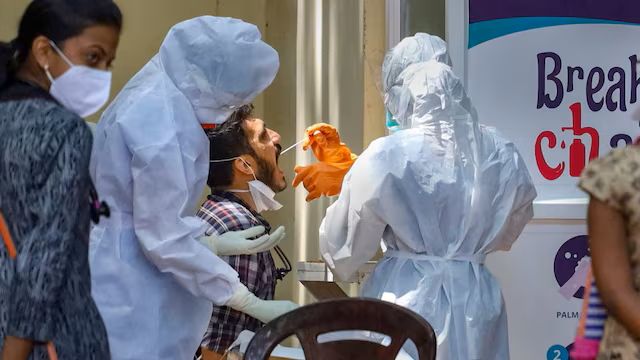
COVID-19 Surge in India, Singapore, and Hong Kong: Health Ministries on High Alert
India has reported 164 new COVID-19 cases since May 12, 2025, bringing the total number of active infections to 257. This uptick coincides with a broader surge in Southeast Asia, where countries like Singapore and Hong Kong are experiencing increased cases driven by the JN.1 variant and its sublineages LF.7 and NB.1.8 .
Regional Distribution of New Cases
The majority of new cases in India have been reported in the following states:
State-wise Distribution of Cases
| State | Number of Cases |
|---|---|
| Kerala | 69 |
| Maharashtra | 44 |
| Tamil Nadu | 34 |
| Karnataka | 8 |
| Gujarat | 6 |
| Delhi | 3 |
| Haryana | 1 |
| Rajasthan | 1 |
| Sikkim | 1 |
Maharashtra also reported two deaths; however, both patients had significant co-morbidities, and doctors have indicated that COVID-19 was not the primary cause of death .
Characteristics of the JN.1 Variant
The JN.1 variant, a descendant of the Omicron BA.2.86 lineage, is currently under close observation by health authorities. It is associated with symptoms such as fever, cough, runny nose, sore throat, fatigue, and gastrointestinal issues. Despite its spread, the World Health Organization has classified JN.1 as a Variant of Interest, noting that it does not appear to cause more severe illness than previous strains
Source: NEWS18
Recent Spike in COVID-19 Cases: A Regional Overview
As the world continues to adjust to a post-pandemic reality, recent COVID-19 case surges in India, Singapore, and Hong Kong have raised fresh concerns among health authorities. According to the latest report from News18, these regions are witnessing a noticeable rise in COVID-19 infections, prompting governments and health ministries to review their public health strategies and reinforce preparedness.
COVID-19 Cases India Singapore Hong Kong
The spike in COVID-19 cases in India, Singapore, and Hong Kong has been a stark reminder that the pandemic is not entirely behind us. In India, the Union Health Ministry has been actively monitoring the situation. Singapore and Hong Kong, both previously lauded for their effective containment strategies, have also experienced upticks, driven by new variants and increased travel.

India’s COVID-19 Status: Review and Preparedness
India has reported a small yet noticeable rise in COVID-19 infections over the past few weeks. The Health Ministry, led by Minister Mansukh Mandaviya, has called for a high-level meeting with experts, state officials, and senior bureaucrats to assess the readiness of the health infrastructure. States like Kerala and Maharashtra have shown localized clusters, leading to heightened surveillance.
Key Measures Taken by India:
- Enhanced genome sequencing of positive samples
- Issuing advisories for mask-wearing in crowded spaces
- Increasing testing capacity in urban centers
- Ensuring the availability of ICU beds and oxygen supplies
COVID-19 Situation in Singapore: Learning from the Past
Singapore has recorded a jump in COVID-19 cases, primarily due to the Omicron subvariants XBB.1.16 and EG.5. While the overall hospitalization rate remains low, the Ministry of Health (MOH) has reintroduced some preventive measures including advisories for mask-wearing in public transport and health facilities.

Current Health Ministry Actions in Singapore:
- Encouraging voluntary mask usage
- Boosting public awareness campaigns
- Offering updated booster vaccines
- Monitoring wastewater for viral presence
Hong Kong’s COVID-19 Strategy: Adapting to a Changing Landscape
Hong Kong’s Center for Health Protection (CHP) reported a modest increase in COVID-19 infections. With the city slowly reopening to international travel, health authorities are keen to avoid previous pitfalls. The Hong Kong Health Ministry has not imposed strict restrictions but has encouraged self-monitoring and vaccination among the elderly and vulnerable populations.
- Public Health Recommendations in Hong Kong:
- Voluntary isolation for symptomatic individuals
- Enhanced health messaging on local media
- Maintaining vaccine centers for elderly
- Reinforcing personal hygiene habits
- Common Factors Driving the Surge
While each region has its unique demographic and healthcare systems, several common factors have contributed to the recent spike in COVID-19 cases:
Increased international travel
- Evolving subvariants with higher transmissibility
- Reduced public adherence to preventive measures
- Weather-related changes affecting immunity
Expert Opinions on the Current Wave
Epidemiologists and public health experts have weighed in on the current scenario. Dr. Randeep Guleria, former AIIMS director, emphasizes the importance of continued surveillance. Singapore’s Health Minister Ong Ye Kung stated that while the rise is concerning, it does not currently overwhelm healthcare facilities. In Hong Kong, experts believe that while community transmission has increased, the healthcare system remains resilient.
It’s essential not to panic but to stay vigilant and follow recommended guidelines,” said Dr. Guleria.
Are New Variants Fueling the Increase?
One of the major concerns is the emergence of new variants such as BA.2.86 (nicknamed Pirola) and EG.5 (Eris). These subvariants have shown mutations that may reduce the effectiveness of prior immunity, whether from past infection or vaccination. Genome sequencing in India and Singapore has identified these strains in recent samples.
What Should Citizens Do Now?
Health authorities across all three regions emphasize personal responsibility and community-level vigilance. Key recommendations include:
Wearing masks in crowded or poorly ventilated areas
- Getting booster shots if eligible
- Maintaining hygiene practices like hand washing
- Avoiding unnecessary travel or gatherings if symptomatic
Comparison Table: Regional COVID-19 Status
| Region | Recent Trend | Variant Concern | Government Action | Public Advisory |
|---|---|---|---|---|
| India | Mild Surge | BA.2.86, EG.5 | Increased testing, masks | Masking, hygiene, booster |
| Singapore | Moderate Surge | EG.5, XBB.1.16 | Booster push, mask advisory | Public campaigns, booster |
| Hong Kong | Mild Increase | EG.5 | Voluntary isolation | Elderly vaccination, hygiene |
Read More About: Rajnath Singh Declares: Indian Armed Forces Have Brought Pakistan’s Military to Its Knees
Final Thoughts
The COVID-19 pandemic has transitioned into an endemic phase for many countries, but the recent upticks in cases from India, Singapore, and Hong Kong show that continuous vigilance is essential. By focusing on community awareness, timely medical intervention, and transparent communication, the spread can be curtailed before it escalates.





